Learn how to write prompts for AI image generators like Midjourney, Stable Diffusion, DALL-E, Flux, and LetsEnhance.io. Refine your skills in prompt engineering to create stunning AI art and make the most of text-to-image apps.
Takeaways
- Use natural language to paint a clear mental picture (e.g., "A curious red fox exploring a misty autumn forest at dawn" instead of "Fox, forest, autumn").
- Include crucial elements: Subject, environment, lighting, colors, mood, and composition (e.g., "A majestic Bengal tiger with vibrant orange fur, stalking through a lush tropical rainforest dappled with sunlight").
- Leverage platform-specific features like aspect ratios in Midjourney (--ar 16:9) or negative prompts in Stable Diffusion.
- Experiment with prompt length: Test short (5-10 words), medium (up to 50 words), and long (50+ words) prompts to find what works best for each AI tool.
- Upscale and enhance: Use tools like LetsEnhance.io to improve resolution and quality post-generation, especially for large prints or detailed edits.
#1 Start from the basic prompt structure
AI image generators work best with clear, structured prompts. This simple framework helps create detailed, rich outputs by guiding the AI effectively:
- Subject: The main focus of the image.
- Description: Context and details about the subject.
- Style/Aesthetic: Artistic approach and visual framing.
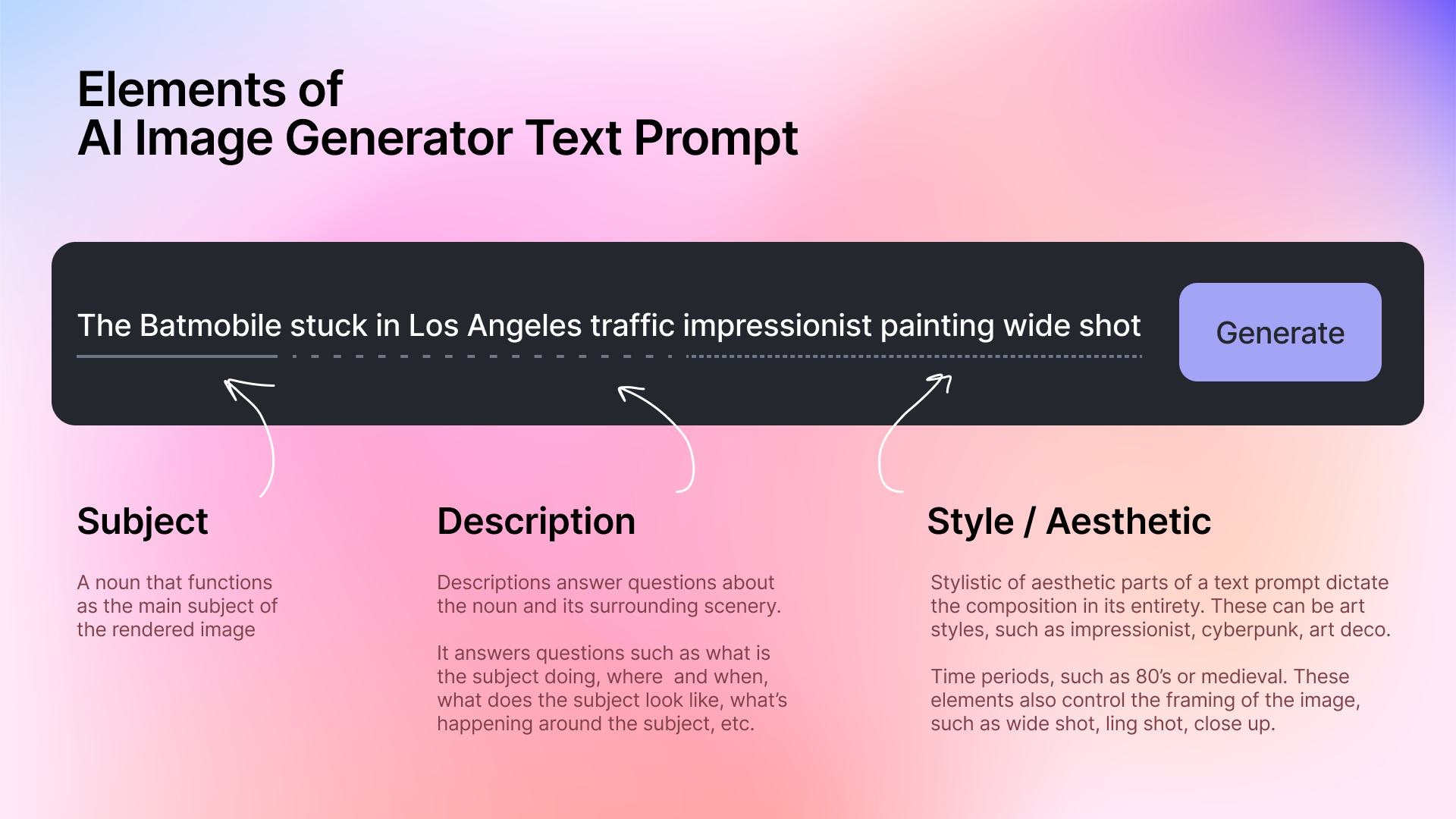
These elements combine into a full prompt. For example: "The Batmobile stuck in Los Angeles traffic impressionist painting wide shot".
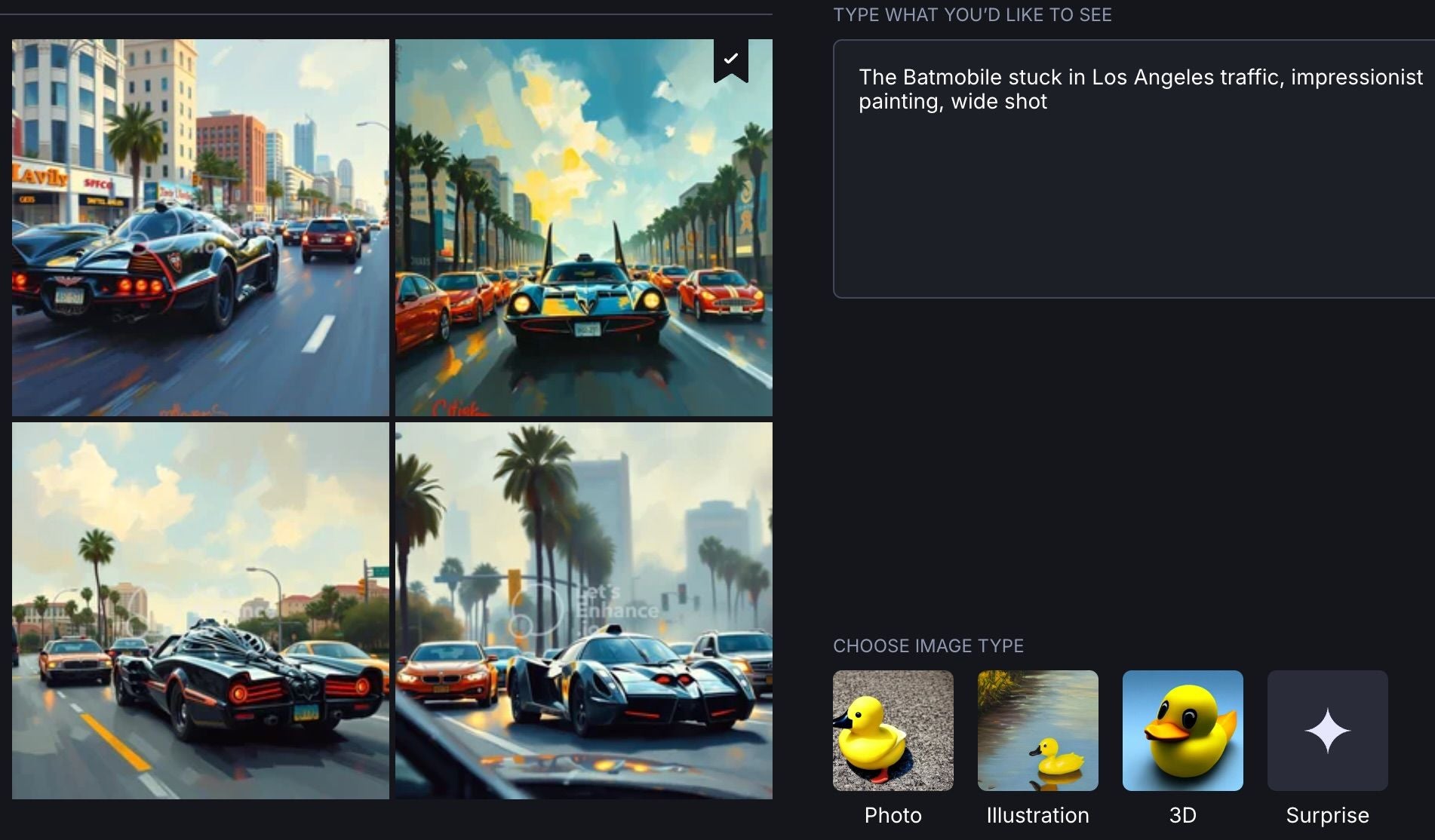
Subject: Who and What
Start your prompt with the main subject, typically a noun. While a single subject can generate a general image, more descriptive prompts usually yield results closer to your vision.
💡 Pro tip: Avoid using abstract concepts (love, hate, justice, infinity, joy) as subjects. Use concrete nouns (human, cup, dog, planet, headphones) as the subject of your prompt for more accurate results.
Description: What They Are Doing, Where, and How
Enhance your prompt with adjectives to add depth and complexity. Include details that answer:
- What is happening?
- What is the subject doing?
- How is the subject doing this?
- What's happening around the subject?
The background is crucial, so don't neglect it in your description.
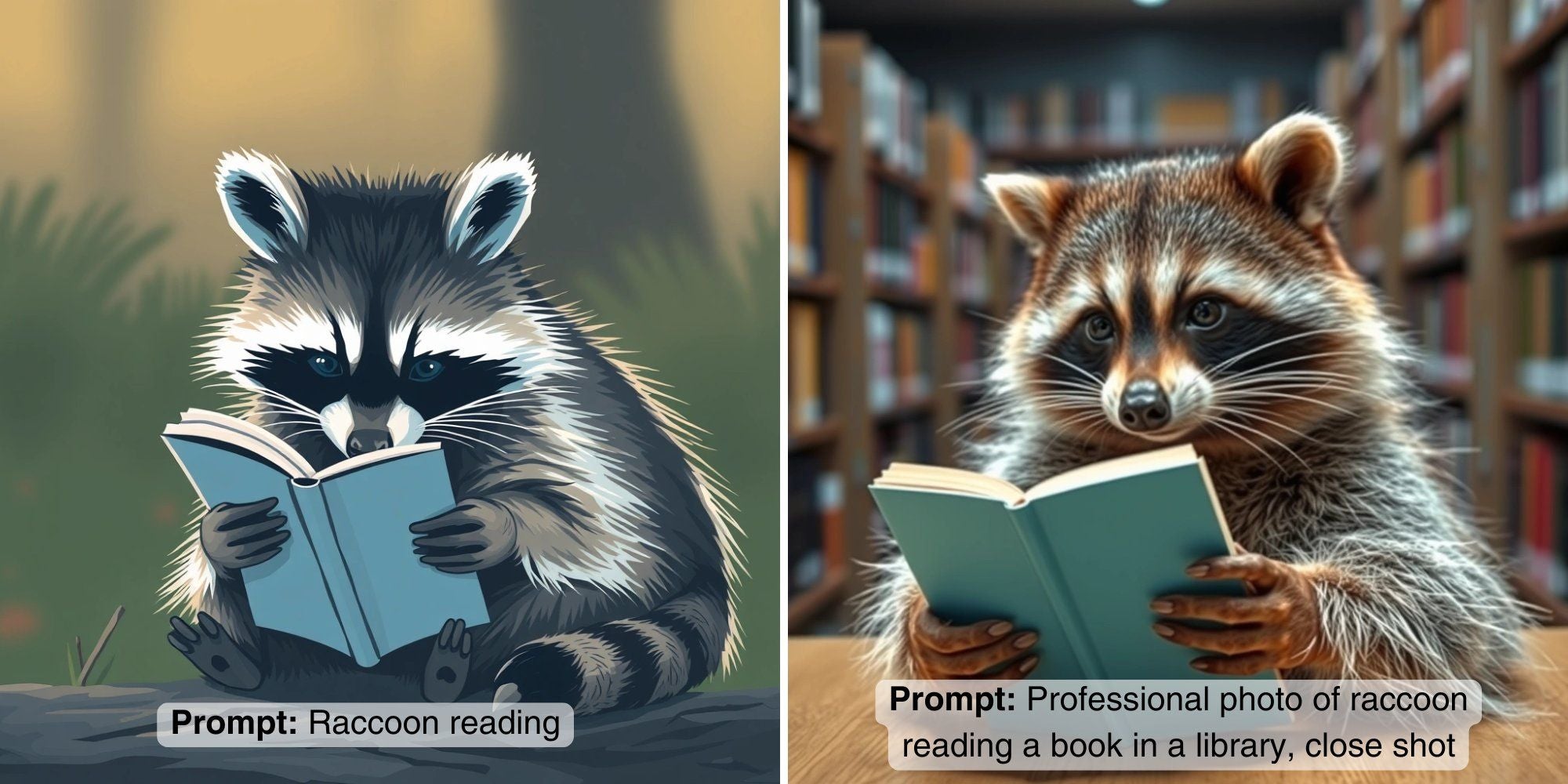
The more detailed prompt resulted in a clearer, more complex and realistic image.
Another example demonstrates how additional descriptors can lead to a significantly more complex and detailed rendering.

This generated image of a finch demonstrates how AI can render a generic, but very accurate image even without additional descriptors. However, the rendering on the right demonstrates how AI image generators, in this case can work with more elements to render a significantly more complex visual.
Aesthetic and Style: How It Looks
Complete your prompt with words that dictate the overall aesthetic and style:
- Medium: "photo", "oil painting", "fresco", "3D rendering"
- Art movements: impressionist, gothic, steampunk, etc.
- Artist influences: Include famous names to blend their styles
- Framing: "close up", "medium shot" to specify angle and distance
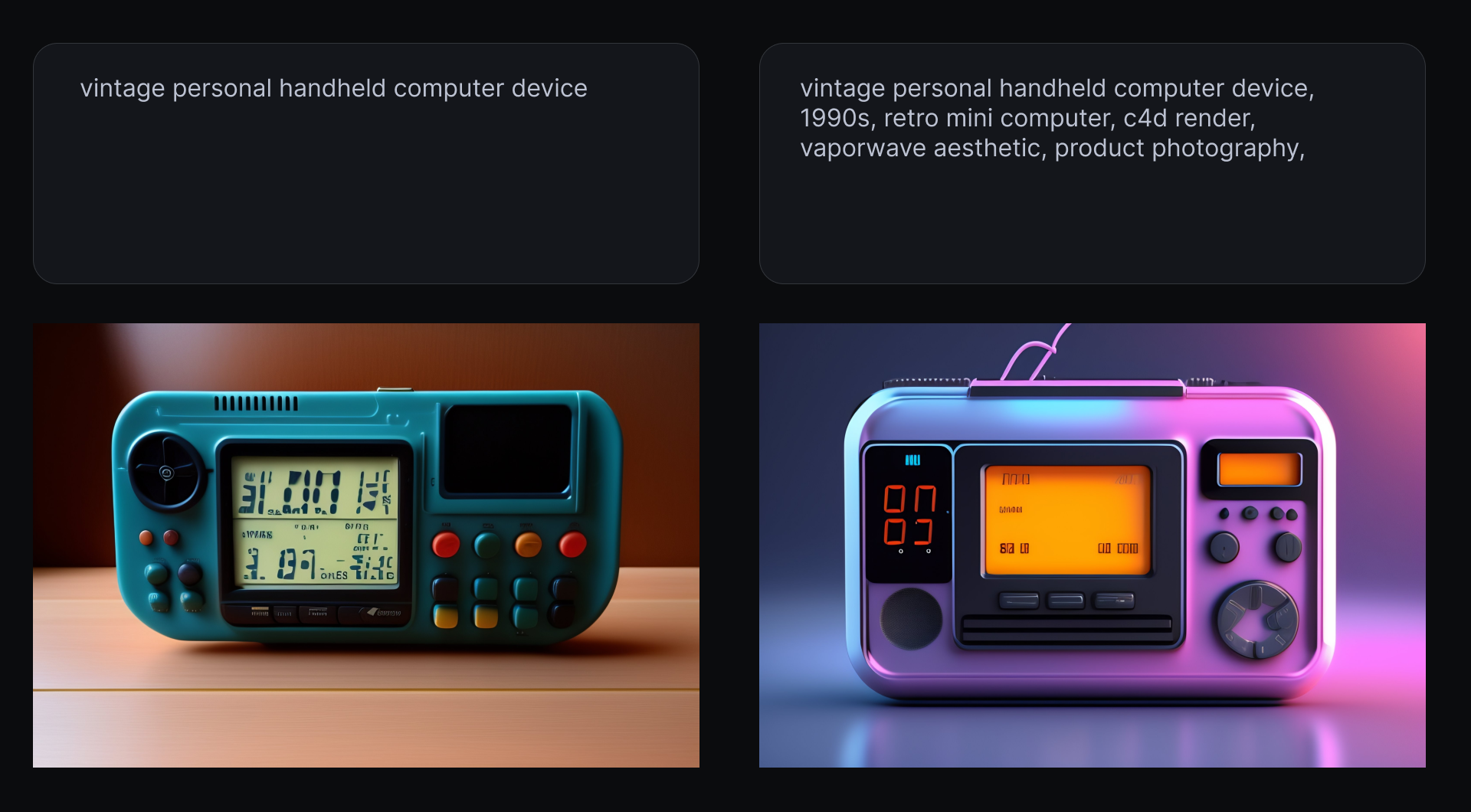
The second prompt resulted in a more defined visual style with neon colors, showcasing the impact of style-specific keywords.
Another example:
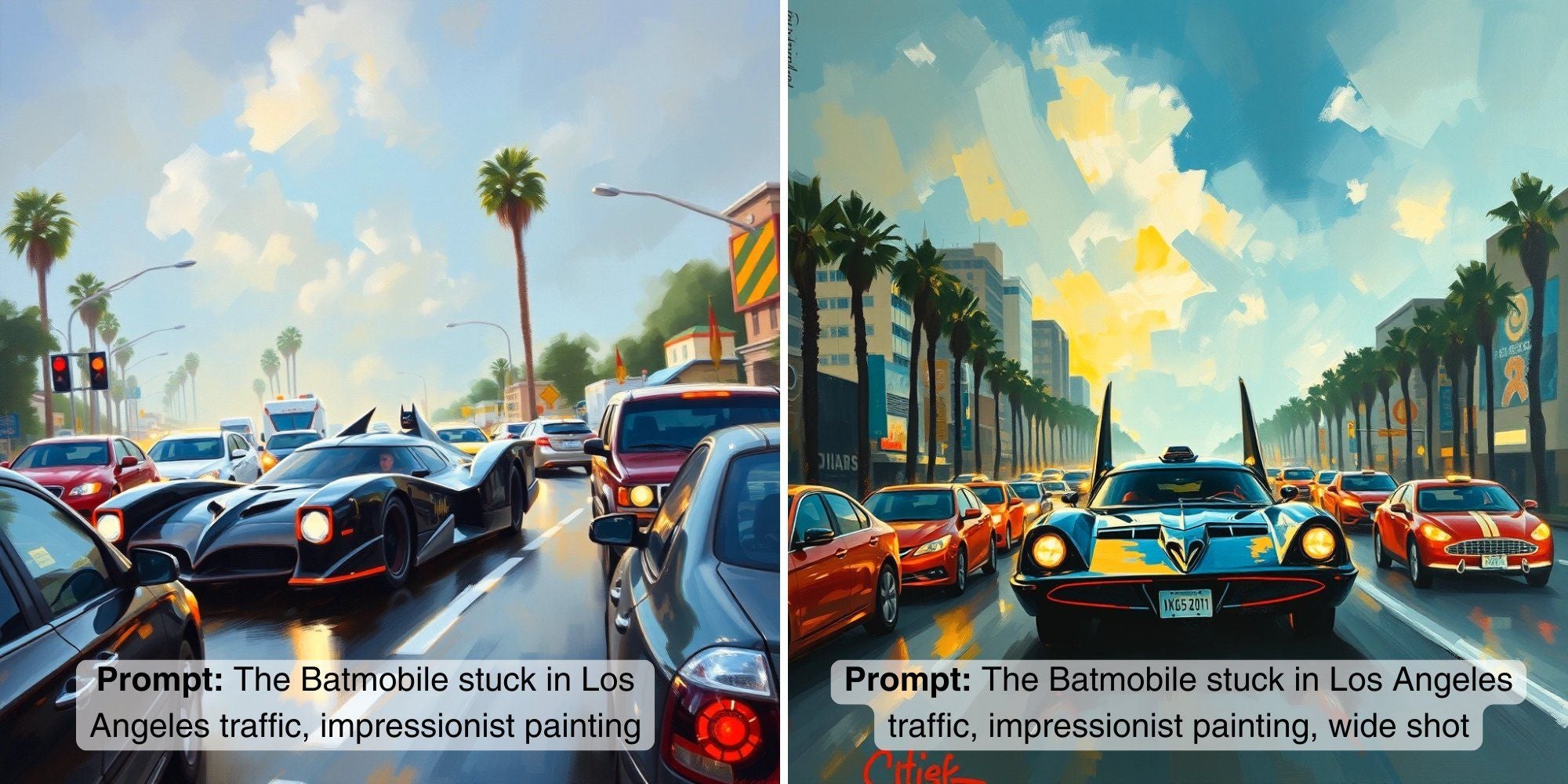
"Wide shot" keyword significantly impacts the image composition. Adding this phrase can change the entire perspective of your generated image.
This structure balances specific details with room for AI creativity. It helps the AI generate images that match your idea while still using its own capabilities.
Using this basic structure is the first step in writing effective prompts. It prepares you for more advanced techniques in prompt writing.
#2 Keep it natural and descriptive
Write your prompts in plain, conversational language. Imagine you're describing the image to someone who can't see it.
Good enough: "Fox, forest, autumn, misty, sunlight, 8k, best quality"
Better: "A curious red fox exploring a misty autumn forest at dawn. Golden sunlight filters through colorful leaves, casting dappled shadows on the forest floor. The fox's fur is slightly damp from the morning dew, and its breath is visible in the cool air."
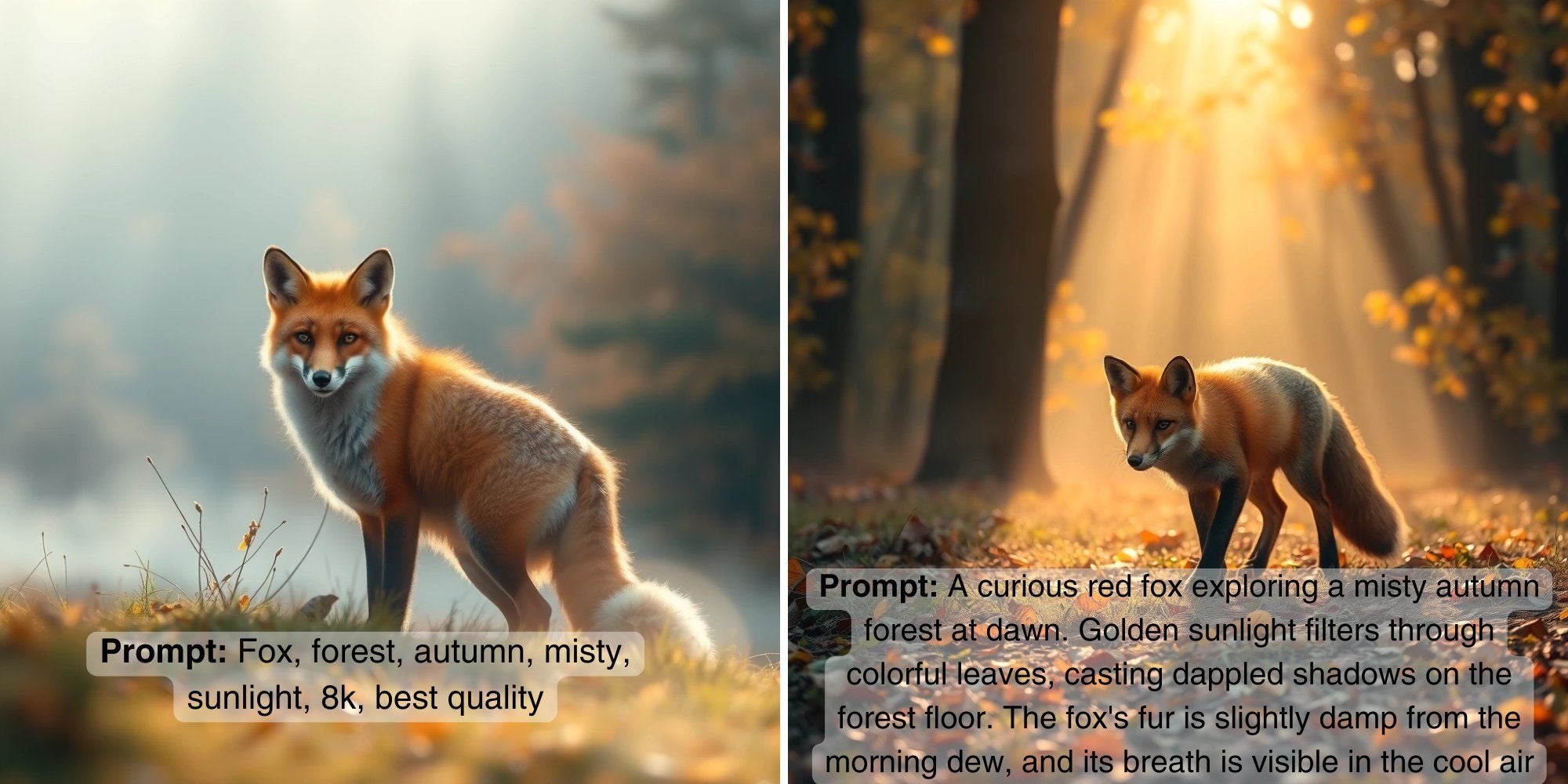
#3 Experiment with length and structure
While some AIs work well with longer prompts, others perform better with concise descriptions. Test different lengths and structures to find what works best for each platform.
1) Short prompt (10-20 words): "Cyberpunk cityscape, neon lights, flying cars"

2) Medium prompt (30-50 words): "A bustling cyberpunk metropolis at night. Towering skyscrapers adorned with holographic advertisements. Neon signs in vibrant blues and pinks illuminate crowded streets. Flying cars weave between buildings."

3) Long prompt (50+ words): "A sprawling cyberpunk cityscape stretches as far as the eye can see. Massive skyscrapers, their surfaces a patchwork of screens and holograms, pierce the smog-filled sky. At street level, a sea of people navigate neon-lit marketplaces and food stalls. Hovering advertisements cast their glow on the rain-slicked streets below. Flying cars and delivery drones zip between buildings, leaving trails of light in their wake. In the foreground, a group of diverse characters in futuristic attire stand on a rooftop, overlooking the chaotic beauty of the city."

Experiment with advanced prompt elements
Include key elements like the subject, environment, lighting, colors, mood, and composition. The more specific you are, the better the AI can interpret your vision.

- Subject: "A majestic Bengal tiger with vibrant orange fur and black stripes"
- Environment: "In a lush tropical rainforest with towering trees and dense undergrowth"
- Lighting: "Dappled sunlight filtering through the canopy, creating a play of light and shadow"
- Colors: "Rich greens of the foliage contrasting with the tiger's orange coat"
- Mood: "A sense of tension and anticipation as the tiger stalks its prey"
- Composition: "The tiger is positioned in the lower left third of the frame, its gaze directed towards the right"
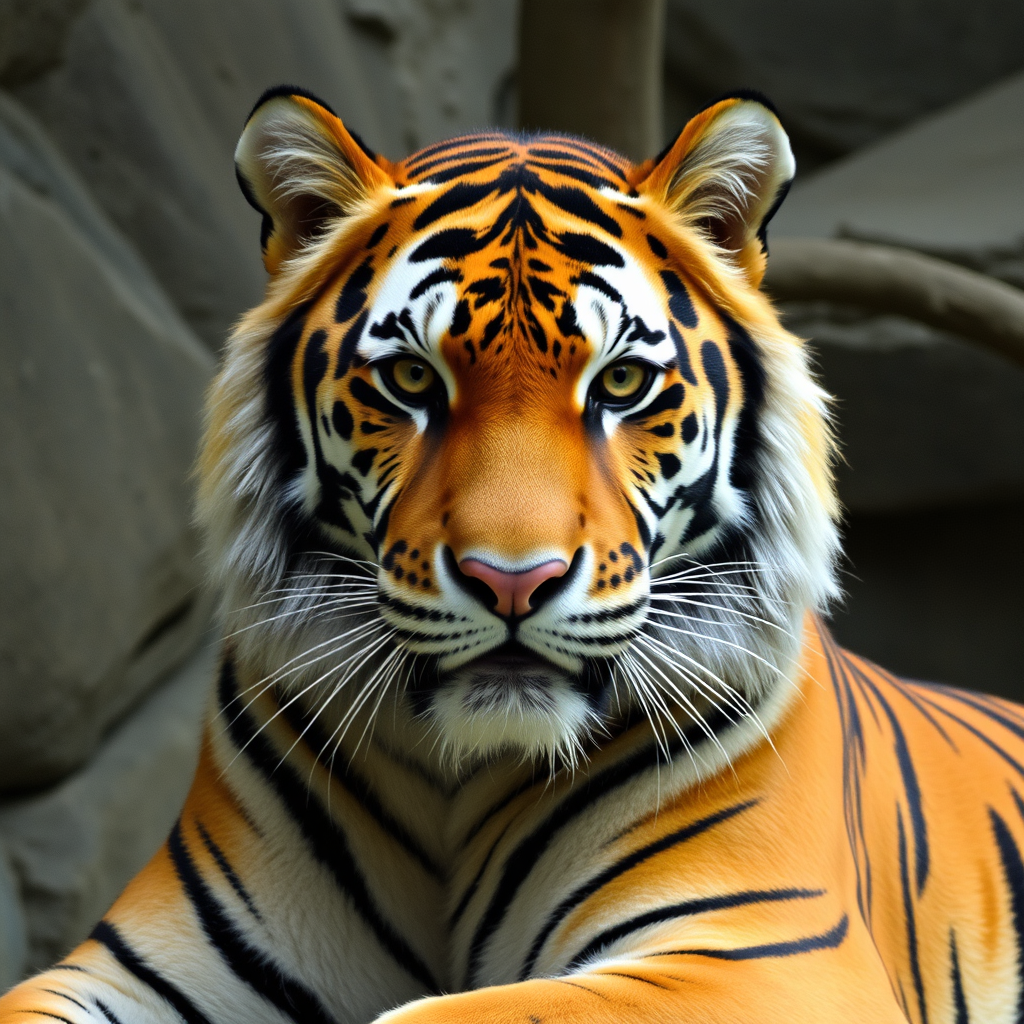
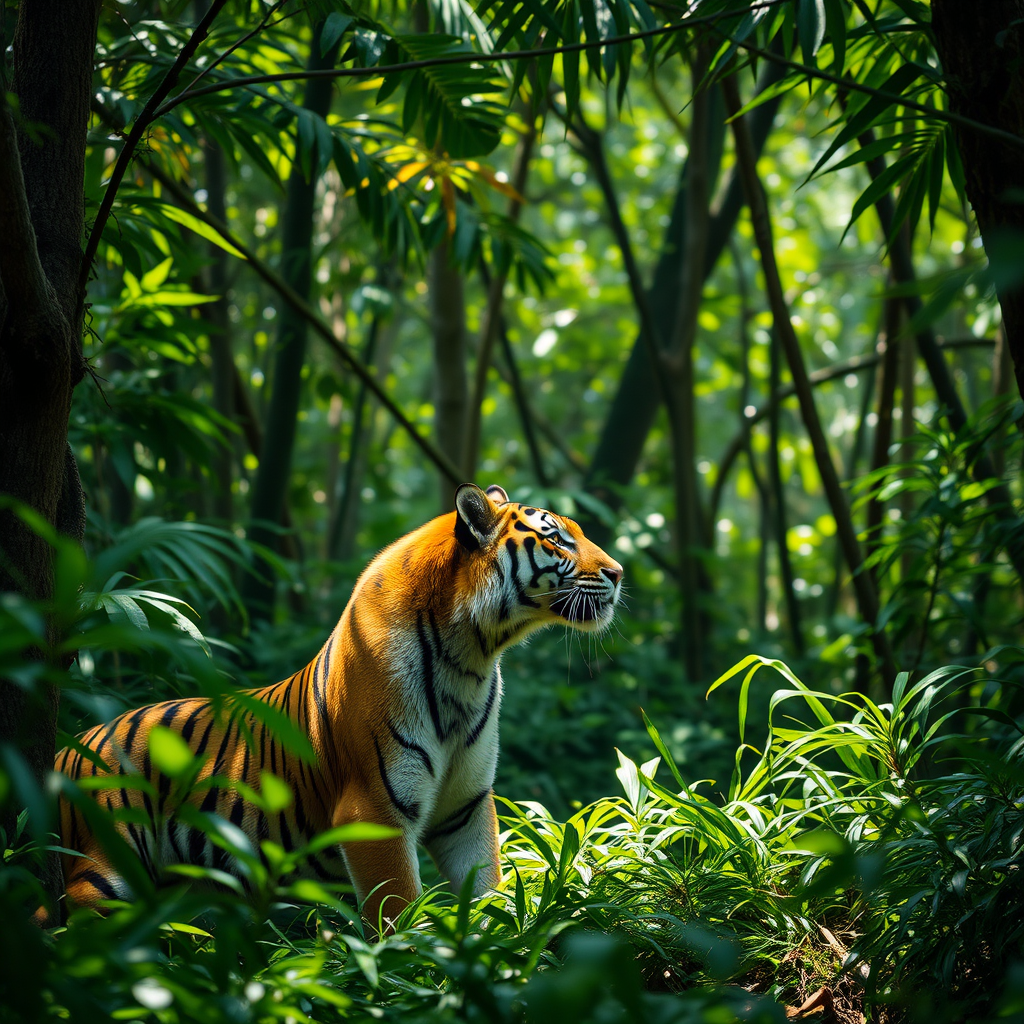
Basic prompt: "Tiger" vs. advanced prompt "Prompt: majestic bengal tiger stalking through a lush tropical rainforest. Dappled sunlight filtering through the canopy, creating a sense of tension and anticipation. Tiger is in lower left, gazing towards the right."
Understand and leverage token weighting
Some platforms allow you to assign more importance to certain words or phrases in your prompt.
- Midjourney example: Use double colons (::) to increase weight (e.g., "blue sky::2" makes "blue sky" twice as important)
- Stable Diffusion example: Use parentheses to increase weight (e.g., "(blue sky)" or "(blue sky:1.5)")
#4 Focus on what you want, not what you don't
Instead of listing what you don't want in the image, focus on describing what you do want. Most AI models respond better to positive instructions.
Exception: Some models, like Stable Diffusion, allow for "negative prompts" to explicitly exclude certain elements. Use these sparingly and strategically.
#5 Use reference images and style modifiers
Many AI image generators allow you to upload reference images or use style modifiers to guide the output.
Example: "Create an image in the style of [Artist Name] or similar to [link to reference image]"
Popular style modifiers: "oil painting", "watercolor", "digital art", "photorealistic", "anime style", "low poly", "impressionist"
LetsEnhance: AI image generation and enhancement
LetsEnhance.io offers a powerful combination of image generation and enhancement capabilities, making it an excellent choice for creating high-quality, detailed images.
Key features:
- Advanced text-to-image generation
- Industry-leading upscaling technology (up to 16x or 512 megapixels)
- Visual prompt builder for easier prompt creation
Tips for effective LetsEnhance.io prompts:
- Leverage natural language: Write descriptive sentences rather than keyword lists.
- Utilize prompt length flexibility: LetsEnhance.io can handle both concise (5-10 words) and detailed (50+ words) prompts effectively.
- Be specific about details: Describe the subject, environment, lighting, and mood in detail.
- Specify colors explicitly: Don't assume the AI will infer color information.
- Avoid technical camera jargon: Terms like "shallow depth of field" or specific f-stops are often ignored.
- Use the visual prompt builder: This tool simplifies the process of creating complex prompts.
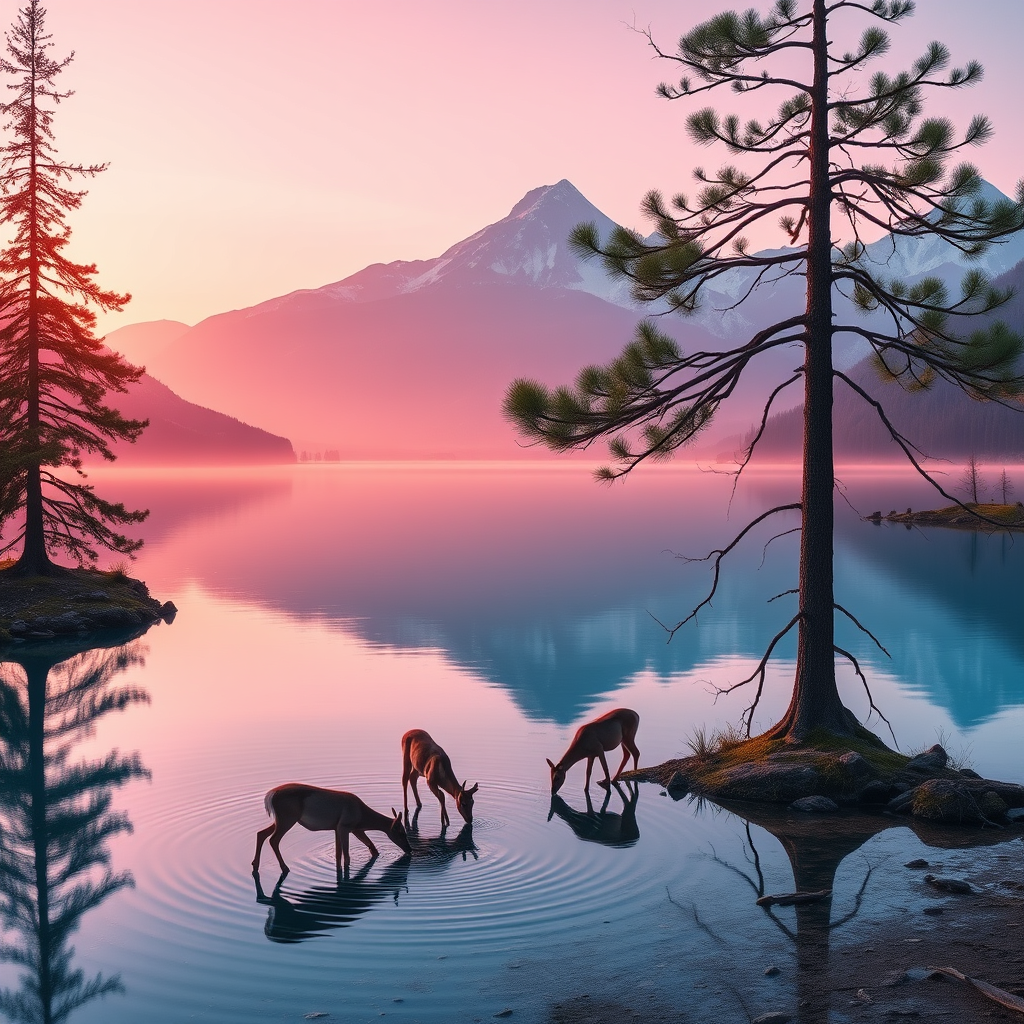
Midjourney
Midjourney v6 and later excel at creating highly detailed and realistic images. It responds well to natural language descriptions and specific artistic styles.
Tips for effective Midjourney v6.1 prompts:
- Use conversational, naturally flowing sentences to describe your desired image.
- Include specific details about materials, ethnicity, age, clothing, colors, textures, shapes, hairstyles, and emotions.
- Incorporate cinematic and photographic terms for more realistic outputs (e.g., "movie still", "cinematic lighting", "depth-of-field").
- Experiment with aspect ratios using the --ar flag (e.g., "--ar 16:9" for widescreen).
- Combine multiple concepts or characters in a single scene for more dynamic images.
- Use the --v {Midjourney version} flag to ensure you're using the latest version.
Advanced Midjourney techniques:
- Use --seed [number] to recreate or iterate on specific generations
- Employ --stylize or --s to control the balance between your prompt and Midjourney's default style (e.g., --s 100 for maximum prompt adherence)

Stable Diffusion (SDXL and SD3)
Stable Diffusion models, particularly SDXL and SD3, are highly versatile and can handle a wide range of prompting styles, from concise to extremely detailed.
Tips for effective Stable Diffusion prompts:
- Use natural language descriptions with specific details about the scene, style, and mood.
- Experiment with longer, more descriptive prompts, as newer models can handle complex instructions.
- Include information about lighting, camera angles, and artistic styles for more control over the output.
- Try using negative prompts to specify what you don't want in the image.
- Incorporate creative and conceptual ideas, as these models excel at interpreting unique concepts.
Advanced Stable Diffusion techniques:
- Use attention weighting with () and [] to emphasize or de-emphasize elements
- Employ prompt scheduling to change the prompt partway through generation
- Experiment with different samplers (e.g., Euler a, DPM++ 2M Karras) for varied results
- Utilize ControlNet for more precise control over composition and pose


DALL-E and ChatGPT
DALL-E (and image generation through ChatGPT) works well with straightforward, detailed descriptions.
Tips for effective DALL-E prompts:
- Use clear, concise language without relying on specific styling keywords.
- Break down complex scenes into separate elements.
- Be specific about composition, perspective, and style.
- Leverage DALL-E's strengths:
- Excellent understanding of spatial relationships and complex scenes
- Strong ability to generate text within images
- Good at following specific style instructions without needing predefined style keywords
DALL-E 3 specific tips:
- Utilize its improved understanding of complex prompts and multi-step instructions
- Take advantage of its enhanced ability to generate coherent text within images
- Experiment with more abstract and conceptual prompts, as DALL-E 3 has improved interpretation of metaphorical language
Example prompt: "Create an image of a cozy bookstore interior. Show tall wooden bookshelves lining the walls, filled with colorful books of various sizes. In the foreground, place a comfortable leather armchair next to a small round table with a steaming cup of coffee and an open book. Warm, soft lighting from antique brass lamps illuminates the scene, creating a welcoming atmosphere. A cat is curled up on a window seat, looking out at a rainy street. Style the image like a digital illustration with a warm color palette, emphasizing the contrast between the cozy interior and the gloomy weather outside."
Flux: New open-source AI image generator
Flux is a versatile, open-source AI image generator that excels at interpreting both traditional keyword-style prompts and more detailed natural language descriptions.
Tips for effective Flux prompts:
- Experiment with both keyword-style prompts and natural language descriptions to find what works best for your needs.
- Take advantage of Flux's ability to handle longer prompts (up to around 500 tokens) for more detailed control over the output.
- Include specific details about subjects, environments, lighting, composition, and mood in your prompts.
- Consider using technical details like camera settings if desired for a more photorealistic output.
- Experiment with different levels of detail in your prompts to find the sweet spot for your specific ideas.
- Use AI tools like ChatGPT or Copilot to expand shorter prompts into more detailed descriptions if needed.
Do's:
- Write detailed, descriptive sentences about what you want in the image
- Include specifics about subjects, environments, lighting, composition, etc.
- Describe the mood and atmosphere you want to convey
- Use AI tools to expand short prompts if needed
- Experiment with different levels of detail to find what works best
Don'ts:
- Don't rely solely on comma-separated keyword lists (although Flux can handle these)
- Avoid overly technical or jargon-heavy language that may confuse the model
- Don't include unnecessary keywords that may not contribute to the desired outcome
- Avoid extremely long prompts over 500 tokens
Example Flux prompts and image results:





Remember, Flux's flexibility allows you to experiment with different prompting styles. You can start with simpler prompts and gradually add more details to achieve the desired results. The key is to find a balance between providing enough information to guide the AI and leaving room for the model's creative interpretation.
Improving resolution and quality
While many AI models have limitations on output size, you can use upscaling tools to increase resolution and enhance quality:
- Generate your image using your preferred AI tool.
- Use LetsEnhance.io's built-in upscalers to increase resolution up to 16x or 512 megapixels.
- Choose the appropriate upscaler based on your image type:
- Smart Enhance for photos
- Digital Art for illustrations and paintings
- Image with Text for preserving small details
- Old Photo for early digital or noisy images
- Magic for creative enhancements guided by text descriptions
Alternative upscaling methods:
- Topaz Gigapixel AI: Powerful AI-driven upscaling with excellent detail preservation
- waifu2x: Free, open-source upscaler optimized for anime-style art
- Cupscale: GUI for various AI upscaling models, allowing for easy comparison and customization
Post-processing techniques:
- Use tools like Adobe Photoshop or GIMP for final touch-ups and adjustments
- Experiment with AI-powered editing tools like ARC Lab's Remini for facial enhancement or Topaz DeNoise AI for noise reduction
- Consider manual retouching for critical areas that AI upscalers may not handle perfectly
Ethical considerations and best practices
- Understand the potential biases in AI-generated imagery and work to counteract them in your prompts.
- Be mindful of copyright and intellectual property issues when referencing specific artists or styles.
- Consider the environmental impact of AI image generation and use resources responsibly.
- Be transparent about the use of AI-generated images in your work, especially in professional contexts.
- Stay informed about the evolving legal and ethical landscape surrounding AI-generated content.
Continuous learning and improvement
- Join online communities dedicated to AI art generation (e.g., Reddit's r/midjourney, Discord servers for various tools).
- Follow AI art creators on social media platforms like Instagram and Twitter for inspiration and tips.
- Participate in challenges and prompt-sharing initiatives to expand your skills.
- Keep a prompt journal to track your experiments and successes.
- Stay updated on new features and model releases for your preferred AI image generation tools.
How LetsEnhance Image Generator Bypasses a Common Problem
Many AI generators have resolution caps to manage processing power. LetsEnhance integrates upscaling AI with image generation AI to bypass this limitation.
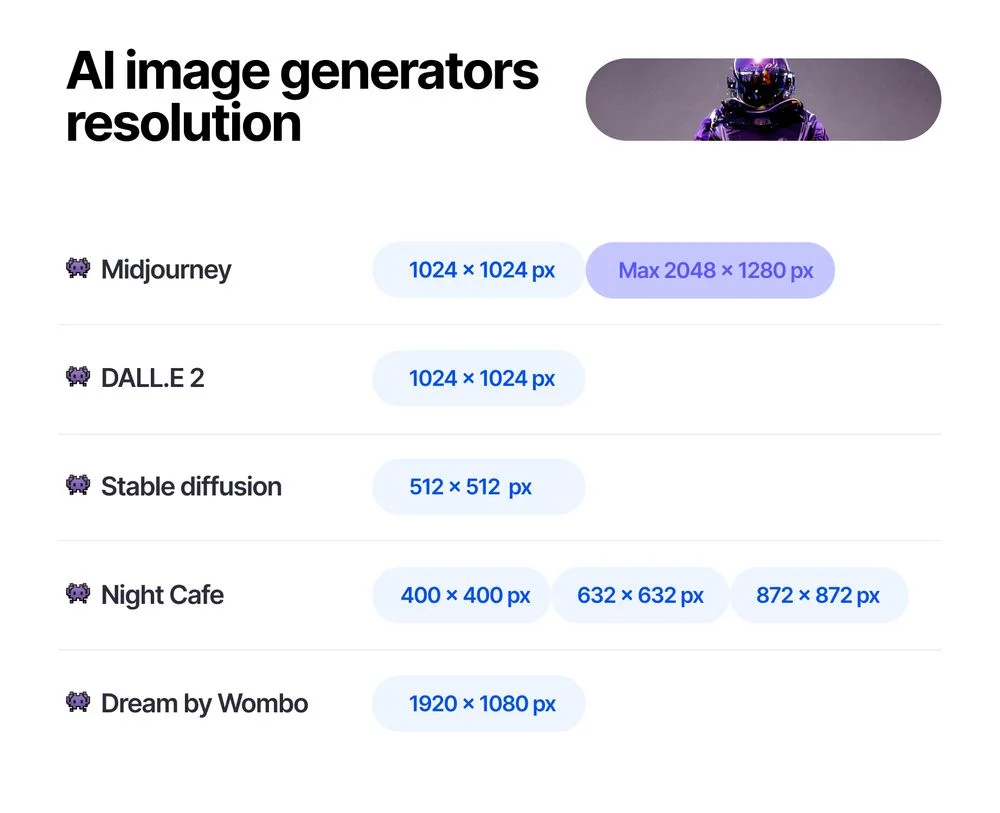
After creation, you can choose between the native 1024x1024px image or upscale it 4x to 4096x4096px without quality loss. This high-resolution output exceeds what most generators offer, even with premium packages. On top of that, you can enlarge the ai art even further – up to 512MP – using our built-in upscalers.

After an image is created, you have the option of receiving it in its native 512 by 512px or upscaling it 4 times to 2048 by 2048px without a drop in quality or the crispness of the image. This is a higher resolution than what most image generators are putting out today, even with the most expensive service packages. This is a great feature for those who work with AI image generators and are looking for high-quality images with a flexible price model.
FAQ
Q: What is the difference between text and image-reference prompts?
A: AI image generation uses two main prompt types:
Text Prompts: Describe the desired image using words or sentences. Different platforms may produce varying results from identical text prompts.
Caption: The Let’s Enhance Image Generator uses text prompts to render images.
The highlighted textbox is an example text prompt used to render images with AI using the Let’s Enhance Image Generator. Depending on the rendering platform you’re using, identical text prompts will have varying results.
Image Prompts: Upload reference images for the AI to use. This can be more effective than text for certain tasks.
Caption: Original: Girl with a Pearl Earring by Johannes Vermeer. Outpainting by: August Kamp
Example: DALL-E's Outpainting can extend existing images, like continuing the "Girl with a Pearl Earring" painting beyond its original borders.
A Mix of Both: Some platforms allow combining text and image prompts for more precise results.
Understanding these prompt types and their applications can significantly improve your AI image generation outcomes.
Q: What can I do if the AI never renders what I was expecting?
A: As we pointed out in one of our short video tutorials, it's best to take it one step at a time with text prompts. First start with the subject and see how it works. Next, try adding a descriptor and if you notice that the renderings are not very clean or comprehensible, try a different descriptor with a similar meaning. Do this until the AI image generator comes as close to what results you were looking for as possible.
Q: What makes a good AI art prompt?
A: A good AI art prompt is specific, descriptive, and includes details about the subject, environment, lighting, colors, and mood. Use natural language and focus on painting a clear mental picture. For example: "A vibrant sunset over a bustling cityscape, with warm orange and pink hues reflecting off glass skyscrapers. Street lights are just beginning to flicker on, and people hurry home from work, creating long shadows on the sidewalks."
Q: How specific should AI image prompts be?
A: AI image prompts should be as specific as possible without becoming overly complex. Include key details about the scene, style, and mood you want to convey. However, different AI models have varying capabilities, so experiment with prompt length and detail to find the sweet spot for each platform.
Q: Can you use negative prompts in AI image generation?
A: Yes, some AI image generators, like Stable Diffusion, allow for negative prompts. These tell the AI what to avoid in the image. For example, you might use a negative prompt like "blurry, low quality, distorted proportions" to encourage higher quality outputs. However, it's generally more effective to focus on positive descriptions of what you want to see in the image.
Q: How do you describe art styles in AI prompts?
A: To describe art styles in AI prompts, use clear, well-known terms and combine them with descriptive language. For example:
- "In the style of Van Gogh's 'Starry Night', with swirling brushstrokes and vibrant colors"
- "Minimalist watercolor painting with delicate, translucent washes of pastel colors"
- "Bold, graphic art deco poster design with geometric shapes and metallic gold accents" You can also reference specific artists, art movements, or time periods to guide the AI's style interpretation.
Q: What are the best practices for AI image prompt writing?
A: Some best practices for writing effective AI image prompts include:
- Use clear, descriptive language
- Be specific about details (subject, setting, lighting, colors, mood)
- Experiment with prompt length to find what works best for each AI tool
- Use style modifiers and artistic references when appropriate
- Leverage platform-specific features (like token weighting in Midjourney)
- Iterate and refine your prompts based on the results
- Keep a prompt journal to track successful techniques
Q: How do different AI image generators interpret prompts?
A: Different AI image generators have unique strengths and interpret prompts in various ways:
- Midjourney excels at artistic and stylized images, responding well to style keywords and weighting
- DALL-E is good at understanding complex scenes and generating coherent text within images
- Stable Diffusion is versatile and supports advanced techniques like LoRA and ControlNet
- LetsEnhance.io combines generation with powerful upscaling, handling both concise and detailed prompts effectively
Experiment with each platform to understand its unique characteristics and adapt your prompting style accordingly.
Q: What elements should be included in an AI art prompt?
A: A comprehensive AI art prompt should include:
- Subject: The main focus of the image
- Environment: The setting or background
- Lighting: Quality, direction, and color of light
- Colors: Specific color palette or important color elements
- Mood/Atmosphere: The emotional tone of the image
- Composition: How elements are arranged in the frame
- Style: Artistic style or technique (e.g., "oil painting", "photorealistic")
- Details: Any specific elements or features you want to include
Q: How can you improve your AI art prompt results?
A: To improve your AI art prompt results:
- Study successful prompts from other users
- Use more specific and descriptive language
- Experiment with prompt length and structure
- Leverage platform-specific features (e.g., weighted terms, aspect ratios)
- Use seed values to iterate on promising results
- Combine AI generation with post-processing and upscaling techniques
- Practice regularly and keep track of what works best for different types of images
Q: How do you use keywords effectively in AI image prompts?
A: To use keywords effectively in AI image prompts:
- Place important keywords near the beginning of the prompt
- Use specific, descriptive words rather than vague terms
- Employ token weighting (e.g., "blue sky::2" in Midjourney) for crucial elements
- Combine keywords with natural language descriptions
- Use style keywords to guide the overall aesthetic (e.g., "impressionist", "cyberpunk")
- Include action words to convey movement or energy
- Experiment with synonym variations to find the most effective terms
Remember, mastering AI art prompts is an ongoing process. Keep experimenting, learning from the community, and refining your techniques to create increasingly impressive AI-generated images.

![How to Write Better AI Image Prompts - From Basic to Advanced [2024]](/blog/content/images/size/w2000/2023/02/Image_Prompt_Guide_cover_1.png)
